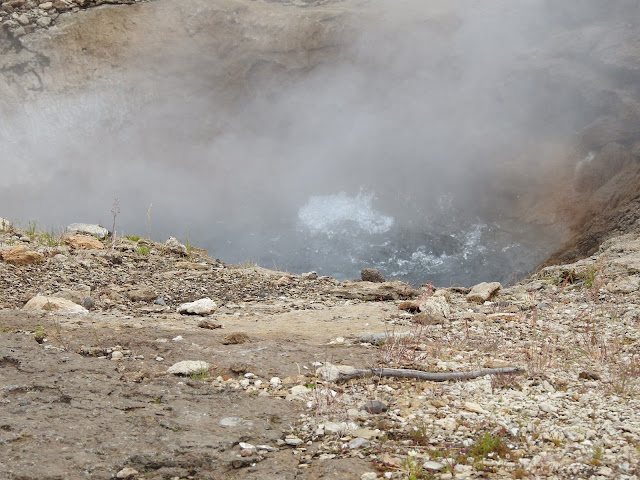There is a lot of street art, both on the street ...

Houses in Reykjavik have some interesting architecture. They range from small houses with corrugated steel sheet siding to some impressive concrete (stucco?) houses. Many (most?) of them have several curious features:
a very plain unassuming front door,
on the side of the house,
with several steps leading up to it, and
with little or no protection from the weather.
We spent two days wandering around the National Museum of Iceland. There were a lot of interesting things to look at. Two of my favorites are:
St. Olav, King of Norway - He is depicted in the armor of the 16th century. He holds his ax Hel ("Death") and his orb of office, as he tramples the devil in the form of a dragon, symbolizing his victory over paganism. (I've never seen a dragon with a head like that!)
Sadly, we were politely asked to leave the ship this morning. Bummer!
We wandered around Reykjavik for a while to get familiar with the city. This is the Coat of Arms for Iceland:

We figured out how to find the street our hotel was on by looking for this sandwich board on the corner of one of the main streets.
To convert from Icelandic Kronor, keep in mind that in Iceland they use the period rather than the comma as the thousands separator so we would write the cheeseburger with fries as 2,500 Kr. Rather a startling figure! But when you convert it to US dollars at a rate of 1 Kr = 0.0073 USD the cost becomes $18.25! Yikes!
We like the commitment to recycling. This is a street trash bin with a holder for drink containers so they can be recycled.
We thought the pizza was pretty much generally not bad.
This is the Islandic 5000 krona bill. When I saw the picture with the needlework I wanted to know more.
On the front is Ragnheiður Jónsdóttir (1646–1715) a wealthy patron of the arts and an expert embroiderer. On the reverse she is shown instructing young women in embroidery. Introduced in 1986, it was the first Icelandic banknote to depict a woman.
This statue is called The Faceless Bureaucrat. It is located near City Hall. Icelanders have a great sense of humor.
Today we were on an 8 hour tour of what is called the "Golden Circle", the most popular tourist route in the country.
Our first stop was at Thingvellir National Park, the only UNESCO World Heritage site on the Icelandic mainland, and one of the three stops on the Golden Circle sightseeing route.
Two of the greatest attractions in the park are the exposed North American and Eurasian tectonic plates; it is one of the only regions in the world where you can see geology such as this on land.
This is the view towards the Eurasian tectonic plate from standing on the edge of the American plate.
It is also here that the world’s first democratically elected parliament (that remains functioning) was formed in 930 AD.
This is a glimpse of some of the amazing scenery. The picture above was taken from the top of the path in the picture below.
